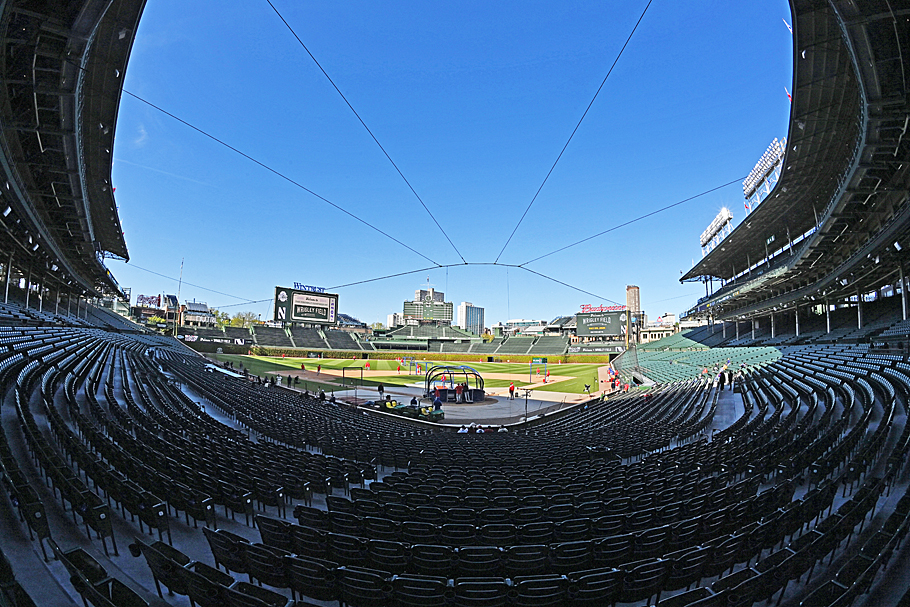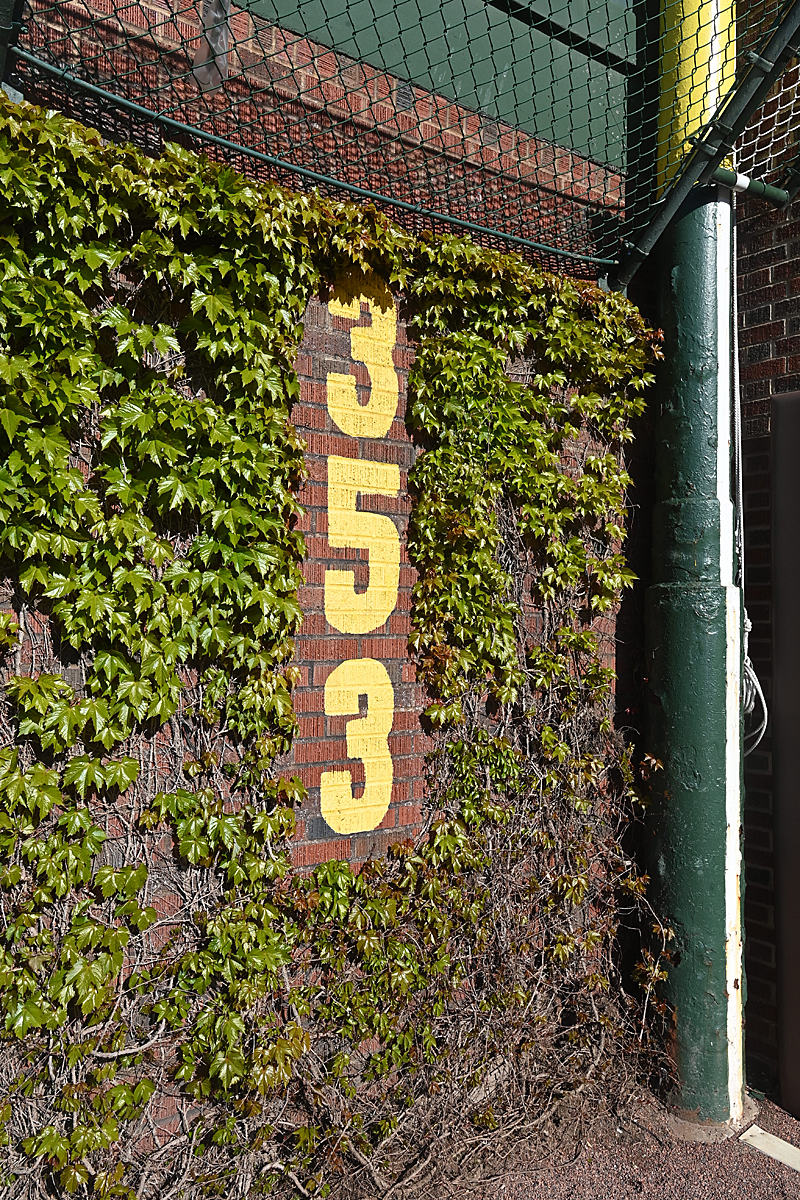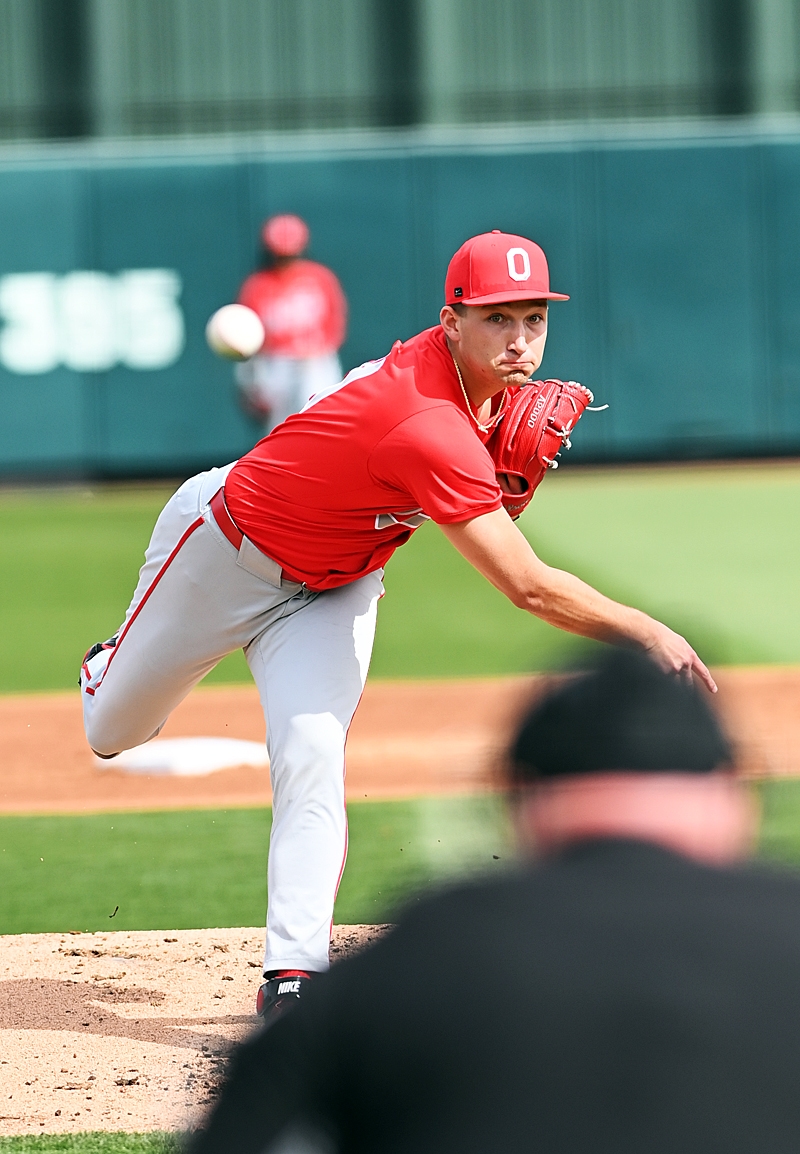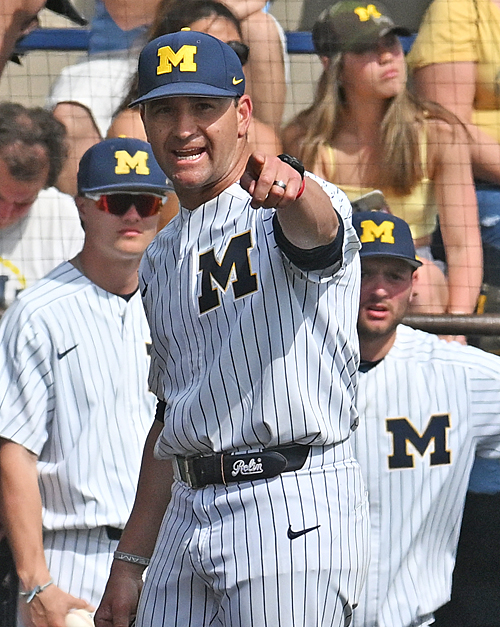
The view that will take your breath away…Wrigley Field in all its sun-splashed glory as shot from the shadows and the sweep of the grandstand. (Press pros Feature Photos)
It was a goosebumps experience, and I did my best to make the best of a unique Nikon moment…what Wrigley Field really looks like when you see it face to face. And with just a week left in the baseball season, where does Justin Haire and staff begin to make the necessary changes for 2026?
 I had put it on the calendar back in March, the first time I heard that there might be an opportunity for the Buckeyes to play one of their three games at Northwestern in the friendly confines, as they’ve been called for years, in historic Wrigley Field.
I had put it on the calendar back in March, the first time I heard that there might be an opportunity for the Buckeyes to play one of their three games at Northwestern in the friendly confines, as they’ve been called for years, in historic Wrigley Field.
And of course a lot of places are referred to as being historic. That gym over in Indiana where they filmed Hoosiers, for instance. But Babe Ruth never played their, or called the home run shot off Cubs pitcher Charlie Root in the 1932 World Series. And this past Friday night I got to stand in the batters box where Ruth stood, and at the spot in right center field where they say his home run passed over. Goose bumps!
 Actually, it was my second visit to Wrigley. The first came back in 1985 when a friend who knew someone got me inside after the season and let me walk around the grandstand. But I never walked on the field – never got to look at some of the iconic spots close-up that I had seen in photos for the past sixty years.
Actually, it was my second visit to Wrigley. The first came back in 1985 when a friend who knew someone got me inside after the season and let me walk around the grandstand. But I never walked on the field – never got to look at some of the iconic spots close-up that I had seen in photos for the past sixty years.
So I grabbed a Nikon camera body that I use to shoot landscapes and covers with and walked the entire warning track…stood in the outfield where Billy Williams had played…at first base where Ernie Banks played…and at the spot in left field where Ernie’s 500th career home run went over the wall on May 12, 1970, against Atlanta – right where the ivy-covered wall bends away toward the left-field foul pole.
And of course, I used a fish-eye lens to shoot the sweep of the grandstand and the playing field from behind home plate…because the color, the old scoreboard in center field, and the Chicago skyline in the background make one of those iconic views that you see on television, but rarely get to see in person, and in an empty stadium.

The dimension sign painted into the bricks of the outfield wall in right field…right at the foul pole.
The dimension signs are interesting to me because they’re literally painted by hand on the bricks of the outfield wall, the ivy trimmed away so you can see them. And the right field shot of the foul pole gives you a good comparison of the ivy as it comes out of winter dormancy and begins to grow back. Notice, too, that there is literally no room between the foul line and the wall in foul territory, one of the distinctive features of Wrigley – why they might have called it the ‘unfriendly’ confines.
You can also see the wire basket that rings the outfield wall, where if the ball hits and stays inside the chain link its a home run…and it also keeps fans with too much Budweiser from falling out onto the playing field.
It was interesting, and as good a thirty minutes as I’ve had in a major league ballpark. And thankfully they’ve kept Wrigley out of harm’s way over the years, because compared to the new White Sox ballpark built back in 1991 when Comiskey Park was torn down…well, there is no comparison. There’s no ambiance on the south side in what’s now called Guaranteed Rate Field. And Wrigley even has an updated version of the trough urinals in the men’s restrooms – and maybe even the women’s restrooms, for all I know.
After all, since I was last there they’ve installed lights and made a few concessions to contemporary culture.
However, the doors on the restrooms still say ‘men’ and ‘women’. I didn’t see any ‘they-them’ rooms.
The Buckeyes lost season is coming to a close…..
Where to begin?
After another ultra-revealing weekend against the twelfth-place Northwestern Wildcats, the Buckeyes lost two of three and were run-ruled in both games they lost. That makes eleven now for the season, and a figure that may never be duplicated again.

The Buckeyes’ Michalak throws hard, but has not figured out how to harness that fastball to the strike zone.
They dropped Sunday’s finale 17-2 (7 innings), and like so many other times this year they were down by double digits after just six outs…10-0 by the end of the second inning.
Starter Jake Michalak walked the bases full in the first inning and Northwestern’s Bennett Markinson emptied them with a triple, and so it went. Michalak was done one out deep in the second after giving up five walks and eight earned runs.
Reliever Nik Copenhaver came on in relief of Michalak to pitch the next three innings, walking six of his own and allowing seven earned runs.
Another reliever, Noah LaFine, pitched the final inning, allowing two runs, and of course, two walks. For the season, now the Buckeyes have allowed a historic 329 walks, compared to 363 strikeouts. And as someone remarked at the ballpark during their Saturday win, “I know at least half of those walks have scored.” One could look it up, I guess.
So with rain in the forecast for Tuesday’s non-conference game with Butler University, it’s pretty good bet that that game may be canceled, leaving only next week’s Big Ten finale series with Illinois left to play. After Sunday’s loss OSU stands 12-35, and Illinois is currently in twelfth place, the last spot for the Big Ten Conference tournament. Northwestern is actually in thirteenth place, so Illinois is going to have all the motivation in the world to not only win the series, but sweep, just to be sure.

Logan Services, in Dayton, Cincinnati, an Columbus, is a proud sponsor of area sports on Press Pros.
So it was talked about during the Northwestern series…just where does Justin Haire and his staff begin to rebuild, revamp, and re-energize Ohio State baseball between June 1 and next February. In fact, a lot of people say they’d like to know.
Obviously they’re going to have to attract pitching, and it’s not being negative to write it when it’s fact. The cumulative earned run average for the Ohio State staff in 2025 is almost 10.00, two points higher than the next worst, Northwestern.
OSU pitchers have inexplicably walked 329 hitters in 390 innings (7.6 per nine innings…no one else is even close), and if you want to know how that compares to first place Iowa, Hawkeye pitchers have walked 208 in 420 innings.

The Hughes Law office, in Urbana, is the official presenting sponsor of OHSAA state baseball tournament coverage on Press Pros Magazine. Call them today if they can help you…Ph. 937-398-0520
Ohio State pitchers have allowed 71 home runs, the second highest number in the conference. Maryland leads in that category, having given up 77 bombs.
The list of pitching insufffiencies goes on and on. But to fix it may be expensive, and in the age of NIL Big Ten baseball is in no position to compete. Landon Beidelschies reportedly got $300,000 to leave Ohio State for Arkansas this year, where he’s 4-0 in eleven starts, with a 4.65 ERA. He, nor anyone else, was going to get that to play for the Buckeyes, and that fact identifies a problem.
How do you recruit and develop pitching talent when you don’t have $300,000 to get them and keep them? And for those who showed up last week for alumni day and questioned the 12-35 record, it’s as simple as generating the kind of commitment that’s found at Florida, LSU, Mississippi, and in Texas.
Go to any of those schools and compare facilities and culture. Baseball in the Big Ten is just a piece of the conference athletic culture. In the SEC, baseball is a culture in and of itself, richly funded by alumni and corporate sponsors. Go to one of those afore-mentioned schools and compare what you see at Maryland and Rutgers. Trust me, it’s eye-opening.

Former Michigan coach Erik Bakich more than doubled his salary when he left the Big Ten for the ACC, and Clemson.
Compare coaching salaries. When Erik Bakich left Michigan to take the Clemson job two years ago, he more than doubled his salary…to $1,275,000 per year, and was recently granted an extension of his contract. The average coach in the Big Ten is in the $400,000 range.
When I asked Ohio State Associate Athletic Director Shaun Richard two years ago about the disparity in what the ACC (Clemson) paid Bakich and Big Ten coaching salaries, he answered the question this way. “We’re not going to chase those numbers. The Big Ten and Ohio State treats its athletes well, and what we can do for our student-athletes ranks with the best across the country.”
And that may be. But there aren’t any baseball players that I know of making $300,000 currently at Ohio State. You may not like it, but it is what it is. And is this the tip of the iceberg?
With or without alumni and corporate support, it’s going to take time. Time to catch up with the rich NCAA brethren in the SEC, and time to recruit and develop the kind of talent who can compete while living a more modest lifestyle.
And by the way, I went to Ohio State 50 years for an education, not to play baseball. That was a bonus. So times have changed.

Publisher Sonny Fulks writes OHSAA sports and the Buckeyes for Press Pros Magazine.
Is Justin Haire the man to do it? I hope so, because I like Justin Haire. You can’t hang 12-35 in 2025 on him unconditionally. And I’ll make the point that what he inherited was something less than a stable household.
But what he does about it between now and May, 2026 will surely reveal more about both the man, and the mission.
I want to see him recruit Ohio baseball athletes, develop them, and win with them. I surely do. But unfortunately, tradition isn’t what it used to be. Quinshon Judkins did not come to Ohio State for the memories. He came for its football culture.
You might say…
Justin Haire and the alumni have a little culture work to do.


